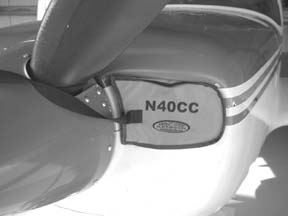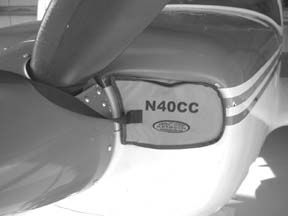
Were constantly surprised at how few owners bother with protective gear for their airplanes-covers and cowl plugs-which sharply limit damage from the suns ultraviolet rays and keep junk and moisture out of the engine compartment. On a recent ramp drive-through, we noted that two in 10 airplanes had covers and only one had cowl plugs.
We think every airplane needs a pair, however. Birds nesting in the engine compartment is a serious safety hazard and has caused fires that have done significant damage. As we discovered recently, even an overnight sit is long enough for some industrious birds to make a mess. In cold country, a pair of cowl plugs is a must to improve the effectiveness of pre-heating and to contain engine heat when a re-start is contemplated within a few hours.
Cowl plugs are as simple as an anvil but we think they need to meet certain requirements. First, fit. Plugs live a rigorous life on the ramp, with wind and prop blast trying to pull them out of the cowl inlets. Our ramp tours revealed one plug hanging forlornly by its cord with the other about to let go. Plug fit should be tight, not just snug. And that argues for a stiffer foam, not something as pliable as a sponge.
We think a cord connecting the two plugs is a must. Or, failing that, flags that project above the cowl lip so you can see them while seated in the cockpit. The reason for this is obvious: sooner or later, you’ll start an engine with the plugs in place. If the cord is properly placed over a prop blade, itll fling the things clear and you can recover them-or whats left of them-from the next tiedown spot.
Last, insulating quality. A plug needs enough foam or plastic density to trap heat in the cowling, thus screen-type material is less effective since it allows the breeze to chill the cylinders. Good in the summer, bad in the winter.
Buy and Try
We bought a selection of the popular cowl plugs marketed in the gadget catalogs or by companies that make covers and protective gear and tried these in our Mooney. The 231 is a cowl-plug challenge because one inlet has an airscoop that protrudes almost flush with front edge of the cowl. Kennon handled this nicely by constructing a two-part plug, one for the scoop, one for the inlet, all this from a photo we sent them. Further, the plugs fit snugly and are well-made with a custom N-number. For $55, these are our top choice. (www.kennoncovers.com)
Next up, Sportys cowl plug isn’t a plug at all but a nylon screen over the inlets. It requires a couple of snaps to be screwed into the cowling and these hold it fast with a pair of Velcro straps. This design has two shortcomings: it has little insulating value and no strap over the prop to self-remove itself should the pilot forget it. Pluses: itll fit anything and it folds up for compact stowing. Cost: $49.95 at www.sportys.com.
Another fit-anything approach comes from Aero Technologies, Inc., which markets a do-it-yourself foam plug kit through Chief Aircraft for $26.95 and through Aircraft Spruce for $30. The kit includes a paper template to mark and cut the foam plus a strap with a remove-before-flight flag. Some skill is required to get the fit right and, in our view, the results don’t look as polished as do custom-made plugs. But at half the price, you may not care about such things. Contact www.aircraftspruce.com or www.chiefaircraft.com.
Aircraft Spruce also sells a line of custom cowl plugs from Cee Bailey. We werent able to obtain a sample of recent production Cee Bailey plugs but weve examined them before and find them, at $51, to be comparable in quality to the Kennons. However, they don’t fit as many models and arent as customizable, in our view. (They didnt have plugs for our Mooney, for instance.)
Conclusion: for a customized plug, go with Kennon. The price is right and the company has excellent customer service. For a serviceable plug, the do-it-yourself Aero Technologies product will get the job done.
Also With This Article
“Kennons Heated Cowl Plugs”


